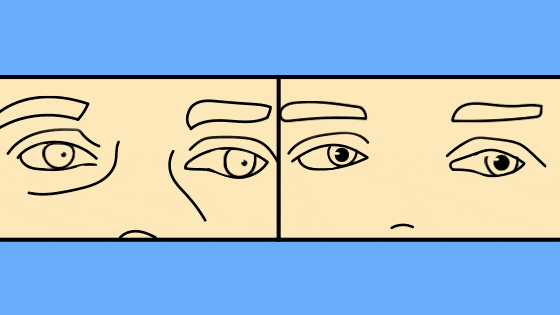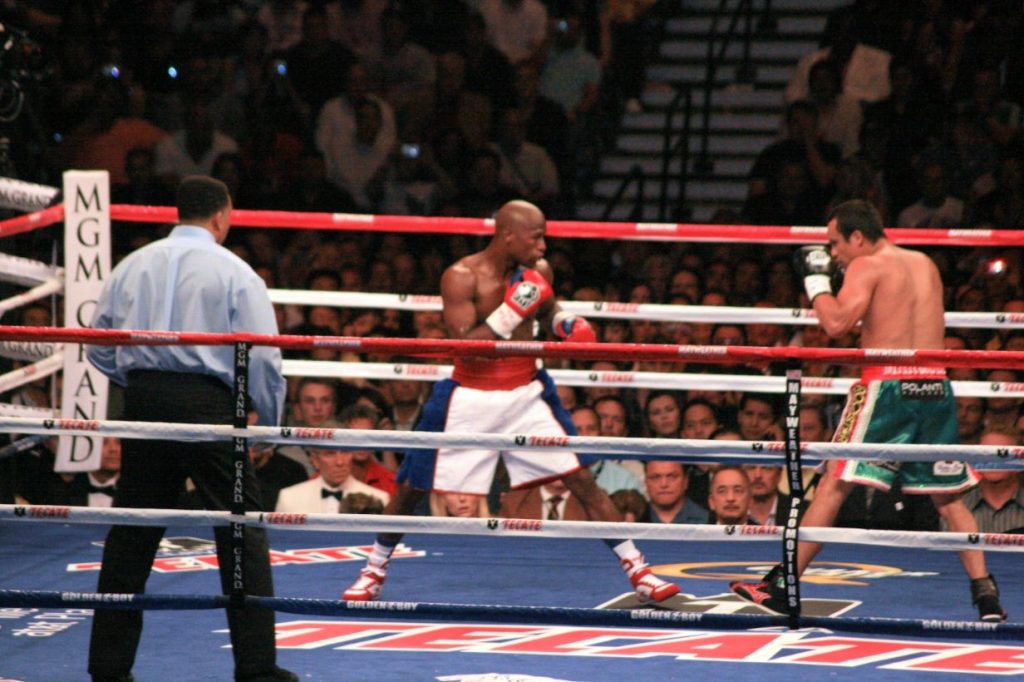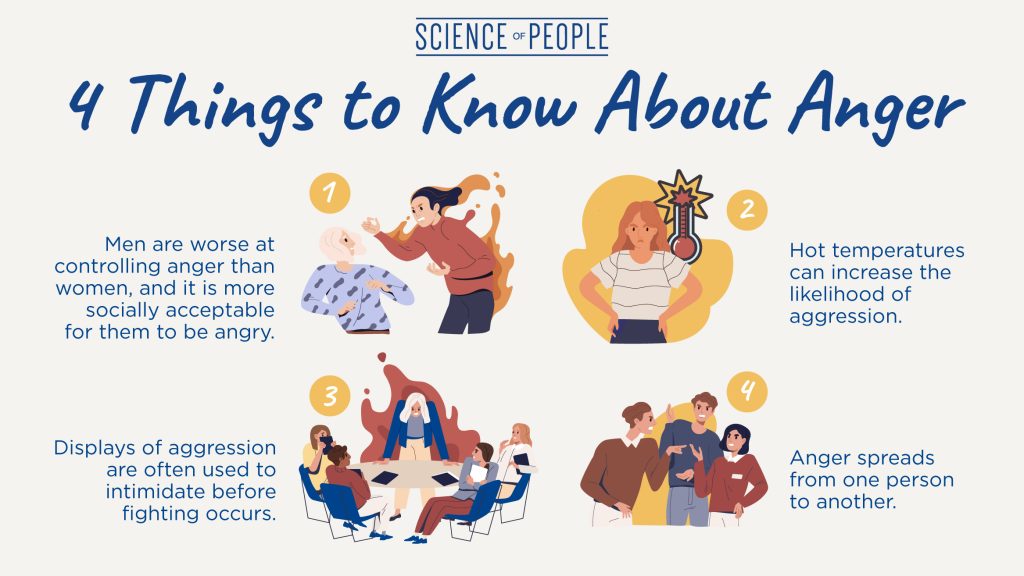This article is part of our body language guide. Click here for more.
Let me tell you a story… it might or might not end with a punch in the face.
You should read this post if you are:
- a frequent bar and nightclub goer
- an athlete who plays full contact sports
- a woman who wants to protect yourself
- someone with a face people just want to punch
Watch our video below to learn how to read people and decode 7 body language cues:
My Bar Story
Last Saturday night, I was at a pool bar with a few friends. One of my friends (let’s call him Dumbo) was shooting pool and really savoring the game—even though there were a few people waiting their turn for a table.
This big biker guy (let’s call him Biker) was really getting annoyed that Dumbo was taking his sweet time. Biker was hovering over the table and started to snort (loudly) every time Dumbo missed a shot.
Then there was a moment—a moment when Biker’s patience ran out. His body language tightened, there was a crackling in the air, and I knew it was not going to end well. I walked over to my friend Dumbo and whispered to him, “Dumbo, I’m pretty sure if you don’t wrap this game up quickly, you are going to get punched in the face.”
He looked at me and laughed, waved me off, and said I was “overreacting” and my “body language instincts” were WAY off.
Dumbo was being pretty obnoxious, so I decided to let it go—a punch in the face might do him some good. Not even 2 minutes later, Dumbo called to the biker, “Want to get me a drink, Dude? I think it’ll be a few more minutes.” Predictably, Biker put down his beer, walked right up to Dumbo, and popped him one in the nose.
Don’t worry, only Dumbo’s face and ego got a little black and blue. While icing the next day, he asked me, “How did you know that guy was going to punch me?”
And that brings me to this post.
- How do you know if someone is going to punch you in the face?
- How can you predict a bar fight?
- What is the body language of violence?
Whether you’re dealing with a drunken bar mate, playing an intense sport, or dating a stranger, you have to know how to recognize the nonverbal behavior of “this does not look good1.”
This post is all about the nonverbal behavior of aggression and what to look out for to protect yourself and your dumb friends.
(And Dumbo, you know who you are. This is for you.)
Let’s take a quick tour of the creepy, violent, and aggressive behaviors you should watch out for:
Jaw Thrust
Also known as a chin jut or a jaw clench, this is when someone grits their teeth and then shoves their jaw out in your direction. When we are feeling angry, we naturally grit our teeth—sometimes to control an emotional outburst and sometimes out of pure frustration. This is also a territorial gesture. When someone chin juts at you, they are threatening your space with theirs. It’s a nonverbal way of saying, “Back up!” Another reason the jaw thrust is confrontational is because it forces the person to look down their nose at you, which is a very standoffish gesture. Look at these three pictures:

The first one is neutral.
The second one, with the chin jut, is the one that should irritate you the most. Don’t I look kind of bitchy? You can’t help but feel that way when someone sneers down their nose at you.
The third one, looking up at you, should be the most seductive. Even though I am not trying to be, anytime a woman looks up at someone through her lashes, she looks more engaging and curious.
De-escalation: Don’t mirror an aggressive person’s behavior. Keep your jaw relaxed, and take one step back to show that you are giving them physical and emotional space.
Nostril Flaring
A nostril flare is when we fan out the outer lobes of our nose so they are as wide as possible. It’s sometimes called “wing dilation.” Flaring our nostrils before a fight is a very important survival mechanism, because when we open up our nostrils, we are able to take in more oxygen. This fills up our lungs and loads our blood with oxygen so we have the energy to fight.
It is possible our nostrils flare before a fight to take in more of the opponent’s smell, as some experts think we can subconsciously smell adrenaline and pheromones. Before a fight, it is good to know as much about your opponent as possible.
Context is important here: nostril flaring can also happen during arousal and attraction. So if it’s happening during bow-chicka-wow-wow, I wouldn’t worry about your partner punching you in the face.
Pursed Lips
The definition of pursed lips is when the lips close tightly together. You may even notice the lips disappearing, depending on the amount of tension a person is experiencing. Pursed lips are commonly seen in rhesus monkeys, who raise their brows, fix their aze, and close their jaws together when disposed to attack1https://www.amazon.com/Nonverbal-Communication-Human-Interaction-Knapp/dp/1133311598.
You might notice pursed lips, even accompanied by rapid blinking, when
De-escalation: Show your palms and offer an explanation if you said something polarizing. You want to show them you are not closed, in case they are disagreeing with you.
Chest Puff
Before getting into a fight, our bodies want to get as big as possible. This happens for 2 reasons. First, when we are bigger, we look more imposing to our opponent—and could possibly scare them off. Second, the more space our bodies take up, the more testosterone we produce. According to Amy Cuddy at Harvard Business School, testosterone (for both men and women) is the strength hormone. It not only makes us perform better and think faster, but it also makes us feel more confident—essential for winning a fight. So someone who is about to act out with violence will often puff out their chest and hold their head high to look as big as possible.
De-escalation: Don’t cower. While you don’t want to puff up like them (this challenges them), you don’t want to cower either. This will not only make you feel worse, but it might encourage them to see you as a weak opponent. You are much better off standing your ground and holding your hands out and open with your palms up. This is the universal “nonthreatening” gesture and signals to them you don’t want to fight.

Pupil Dilation
This is a hard one to catch, but I wanted to point it out. When we are under stress, our brain goes into fight, flight, or freeze mode where it needs to assess the environment incredibly quickly to decide what to do next. If someone is feeling threatened and is considering getting violent with you, their pupils expand to take in as much of the surroundings as possible—do you have friends with you, could you be carrying a weapon, what’s the escape route? This might even be happening totally subconsciously, but you can be aware of this subtle change to predict aggression.
Yet again, pupil dilation also happens during arousal. Specifically when men see a naked woman or when either sex is in orgasm. Why? Our eyes want to take in as much of a good thing as possible. Again, if you take off your clothes in front of a man and his pupils dilate, it’s a good thing. More body language of attraction here.
Lowered Eyebrows
Tense or lowered eyebrows is usually a very dominant gesture. Someone might express feelings of anger by lowering their eyebrows. Their heads could also be tilted downward. This type of stare is characterized as a long, hard stare that has little to no blinking.
Even cats stare angrily at each other before getting in a fight! Sometimes this works, and the other cat backs down. But other times…
Teeth Licking
Licking your teeth is usually seen as a sign of aggression since teeth are a primitive weapon that we use when threatened. It can happen right before a fight or if someone enters your comfortable space without permission.
Licking teeth can sometimes be seen even when the mouth is closed. For example, you might notice a tiny movement on the jaw area or side of the face that pushes the jaw up and slightly widens it2https://www.amazon.com/What-Every-Body-Saying-Speed-Reading/dp/0061438294.

Blading (Aggressive Stance)
Blading is when you turn your body away from the threat so less of your torso is visible to them. In other words, instead of facing someone front on, you pull your leg and shoulder back so the opponent can only see and access the side of the body. In boxing, you can see both competitors in the blading position where their dominant leg moves back.
Blading happens for multiple reasons:
- When you blade, fewer of your vital organs are exposed. Your shoulder and arm can take harder hits than your stomach or eyes.
- When you blade in preparation for violence, typically your dominant leg steps back. When the nondominant leg steps back, you are more solid on your feet (it’s harder to get pushed back).
- When you blade, you can punch with more power.
If you see someone step back with their dominant leg and bring their arms up, it’s time for you to get the heck out of Dodge.
De-escalation: Defuse an argument before blading happens. Since blading may likely occur from a front-on position, then try going from a frontal position to sitting or standing shoulder to shoulder. Don’t square off, or you may increase hostility and escalate3https://www.amazon.com/Silent-Language-Leaders-Help-Hurt-How/dp/0470876360.
Tightened Muscles
When someone is preparing for a physical altercation, the brain wants to protect vital organs. The way the body does this is by creating a muscular armor around soft tissue. Have you ever seen those videos of magicians getting punched in the stomach? They are able to do this by clenching their stomach muscles that protect the sensitive intestines. When someone’s entire body tenses up, they are protecting their vitals and getting increased blood flow to their limbs in order to fight or flee faster.
Special Note: Clenching fists is another type of tightening that happens around anger. When we are angry, we often tightly grip our hands into tough fists. If you are speaking with someone and notice they have just tightened their grip, tread carefully.

Sneering (Aggressive Face)
The definition of sneering is a disgusted and angry facial expression, characterized by a corner of the lip rising upward. It is typically caused by anger, irritation, or if a person is under physical and emotional threat4https://www.amazon.com/Definitive-Book-Body-Language-attitudes/dp/1409168506. The teeth may be visible during a sneer.
Gymnast McKayla Maroney gives a good example of sneering5https://www.irishtimes.com/sport/other-sports/america-at-large-maroney-casts-new-light-on-sexual-abuse-in-us-gymnastics-1.3268196. She even made her “not impressed” sneer famous after she lost out on a gold medal.
Clenched Fists
While open fists may indicate openness and acceptance, closed fists can show anger and dismissal. Watch for clenched fists at the side of the body—the harder a person clenches, the more muscle around the forearms you can usually see.
Clenched fists are also a preparation before a punch. If you see clenched fists, be prepared to sidestep a punch or get out of Dodge before that happens.
Foot Stomping
Foot stomping is when someone slams their foot down. You can observe the foot stomp in young kids when they’re forced to do their homework:
Otherwise, foot stomps are an indication of repressed anger.
De-escalation: When you see the foot stomp, calmly take a step back. A foot stomper can be like a rhino ready to charge, so be prepared to give them space.
Ocular Orbital Tension
The ocular orbital muscles are right around your eyes. When people are suspicious (or, at best, intensely curious), their ocular orbitals will tighten. You might think of this as a glare or “narrowing your eyes” at someone. This is the best one to notice to prevent escalation, because when suspicion or dislike is addressed early, it can prevent a fight.
De-escalation: If you say something and see the other person narrow their eyes at you, go right into clarification and explanation mode. Figure out exactly what they are hung up on and how to address it.
One Leg Up
If you ever find yourself sitting on a bar stool and someone rests their foot on it, this can indicate ownership of the chair6https://www.amazon.com/You-Say-More-Than-Think/dp/0307453987. This indicates someone is trying to mark their territory, and you are part of it. You might see a person claiming chair ownership in groups where one person is the alpha. This isn’t necessarily anger, as it can be a sign of confidence or comfort, but it is a good thing to note if someone is claiming territory.
Rattling
You know how a rattlesnake shakes its tail at you to warn you not to step any closer? Humans can sometimes do this to test their limits. This video shows a lot of rattling behavior with tons of touching and shoving:
Before getting violent, perpetrators will sometimes do the following to mess with your space and get you rattled:
- Any kind of interaction with your belongings. They push aside your beer. They jangle the strap on your purse. They nudge your backpack with their foot. They take a sip of your drink. These are ways that they get in your space and invade your limits.
- Any kind of unwelcome physical touch. They flick the side of your lapel. They fluff your hair. They give you a shove on the shoulder or an unfriendly pat on the back. These are meant to be invasive and to see how you will respond.
Special Note: The human form of rattling could also be the growl. Growling (yes, it happens with humans) is a very primal instinct when responding to a threat. If you hear a voice (especially a man’s) getting really low and gravely, watch out!
4 Things to Know About Anger
Anger is a mysterious emotion, but one that can be explained with science. Here are some more interesting angry body language facts to know:

Men vs. Women
One study, by scientists at Southwest Missouri State University7https://www.sciencedaily.com/releases/2000/01/000131075609.htm who surveyed around 200 men and women, found that women got as angry as men. However, men were found to be worse at controlling their anger than women. That’s why men may be more likely than women to express their anger nonverbally3https://www.amazon.com/Silent-Language-Leaders-Help-Hurt-How/dp/0470876360.
Yale and Northwest University also found that women who have angry outbursts in professional settings are seen as having less power, status, and competence than angry men. The thinking goes that anger in women reveals some sort of personal flaw, like “Oh, it must be that time of month again!”3https://www.amazon.com/Silent-Language-Leaders-Help-Hurt-How/dp/0470876360 But anger in men? It is seen not as a personal flaw, but coming from external circumstances3https://www.amazon.com/Silent-Language-Leaders-Help-Hurt-How/dp/0470876360.
Hot Temperature
Hot temperature increases the likelihood of someone behaving more aggressively or angry. For example, some drivers display aggressive horn honking if there’s a lack of air conditioning in the car1https://www.amazon.com/Nonverbal-Communication-Human-Interaction-Knapp/dp/1133311598.
In a simulated-burglary study, officers reported that hot temperature makes them more aggressive and threatening toward a suspect, and they are also more likely to draw their weapon1https://www.amazon.com/Nonverbal-Communication-Human-Interaction-Knapp/dp/1133311598.
Aggressive Displays
In the animal kingdom, fighting is done to establish dominance in a social hierarchy or defend personal territory. During a real fight, the winner is most likely to be wounded badly. Therefore, most real fights are avoided by displays of power, threats, or counterthreats to avoid physical escalation.
And even though we avoid aggression in real life, we still have outlets for our primal instincts—we watch action on TV and play violent games so we can still get our aggressive “fix” in the modern world. We might even play fight, similar to how dogs lower the front end of their bodies when they play. Humans can play fight in the form of smiling and exaggerated movements8https://www.amazon.com/Peoplewatching-Desmond-Morris-Guide-Language/dp/0099429780.
The Anger Effect
If someone provokes you, but you are afraid to attack them, the anger or aggression may be transferred or redirected to someone less intimidating8https://www.amazon.com/Peoplewatching-Desmond-Morris-Guide-Language/dp/0099429780.
Anger ripples out into the world. Cause one person to be angry, and chances are the anger will be passed on.
This negative energy is almost like a kinetic chain effect. For example, a boss yells at his assistant, the assistant yells at the secretary, and the secretary at the office boy. This is where the popular phrase comes in and is used to typify aggression: “and the office boy kicked the cat.”
And have you ever wondered why domestic abuse cases happen? In 1996, more than 2 million cases of battered women were reported in the US. Attacks from male partners were the single biggest cause of injury, and 76% of these aggressive men had been battered as children. Even more shocking is that 50% of women who were battered also battered their own children!
In other cases, anger can also be directed to inanimate objects, such as when someone pounds a desk. This is common in more recent activities that are sometimes known as “rage rooms.”
Hopefully, you will never be exposed to these anger cues yourself or see them aimed at a friend. But knowing the predictors of violence is an extremely helpful tool to have in your skillset for whatever situation you may find yourself in.
How to Calm Yourself Down
If you’re displaying angry or aggressive body language yourself, you should know how to quickly calm yourself down in any situation. For your next steps, consider one of these guides to ease your anger or other wonky emotions:
- 14 Amazing Benefits of Meditation
- How to Get Out of a Funk (5 Ways to Stop Being Depressed)
- 5 Proven Ways to Cultivate Your Compassion (Backed by Science!)
Crack The Code on Facial Expressions
The human face is constantly sending signals, and we use it to understand the person’s intentions when we speak to them.
In Decode, we dive deep into these microexpressions to teach you how to instantly pick up on them and understand the meaning behind what is said to you.
Learn how to decode emotions in our advanced communication course, People School.
Side Note: As much as possible we tried to use academic research or expert opinion for this master body language guide. Occasionally, when we could not find research we include anecdotes that are helpful. As more research comes out on nonverbal behavior we will be sure to add it!
This article is part of our body language guide. Click here for more.
Article sources
- https://www.amazon.com/Nonverbal-Communication-Human-Interaction-Knapp/dp/1133311598
- https://www.amazon.com/What-Every-Body-Saying-Speed-Reading/dp/0061438294
- https://www.amazon.com/Silent-Language-Leaders-Help-Hurt-How/dp/0470876360
- https://www.amazon.com/Definitive-Book-Body-Language-attitudes/dp/1409168506
- https://www.irishtimes.com/sport/other-sports/america-at-large-maroney-casts-new-light-on-sexual-abuse-in-us-gymnastics-1.3268196
- https://www.amazon.com/You-Say-More-Than-Think/dp/0307453987
- https://www.sciencedaily.com/releases/2000/01/000131075609.htm
- https://www.amazon.com/Peoplewatching-Desmond-Morris-Guide-Language/dp/0099429780
How to Deal with Difficult People at Work
Do you have a difficult boss? Colleague? Client? Learn how to transform your difficult relationship.
I’ll show you my science-based approach to building a strong, productive relationship with even the most difficult people.


